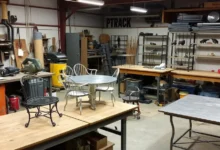The Ultimate Guide to Woodworking Benches: Types, Plans, and How to Choose the Right One
Introduction
Woodworking is an art that begins with the right foundation—and that foundation is your workbench. Whether you’re a hobbyist carpenter or a professional woodworker, choosing the perfect woodworking bench can distinguish between a frustrating project and a masterpiece. In this comprehensive guide, we’ll walk you through everything you need about woodworking benches, from understanding their fundamental role to selecting the ideal bench for your specific needs.
What is a Woodworking Bench?
A woodworking bench is more than just a simple table. It’s the heart of your workshop—a robust, stable surface designed to support your projects, hold your materials, and provide multiple clamping and working options. Unlike regular tables, a quality woodworking bench is engineered to withstand significant pressure, provide precise work surfaces, and accommodate various woodworking techniques.
Types of Woodworking Benches: A Detailed Breakdown
1. Traditional Workbench Styles
European/French Workbench
- Characterized by a thick, heavy top
- Typically features a front vise and tail vise
- Known for exceptional stability and precision
English Workbench
- Features a traditional design with robust construction
- Often includes multiple dog holes for versatile clamping
- Emphasizes durability and functionality
Scandinavian Workbench
- Minimalist design with clean lines
- Lightweight yet sturdy construction
- Excellent for smaller workshops and mobile setups
American Workbench
- Combines practicality with robust design
- Often features integrated storage solutions
- Adaptable to various woodworking styles

2. Specialized Workbench Types
Mobile/Rolling Workbench
- Perfect for small workshops
- Equipped with wheels for easy movement
- Ideal for DIY enthusiasts and space-conscious crafters
Folding Workbench
- Compact design that can be stored easily
- Great for temporary workspaces
- Sacrifices some stability for portability
Workbench with Storage
- Integrated drawers and shelves
- Keeps tools organized and accessible
- Maximizes workshop efficiency
Specialty Benches
- Carving Workbench: Lower height, specialized for intricate work
- Luthier’s Workbench: Designed specifically for instrument-making
Key Features to Consider When Choosing a Woodworking Bench
1. Size and Dimensions
- Consider your workspace and project needs
- Ergonomic height is crucial (typically 34-36 inches for most woodworkers)
- The width should accommodate your largest anticipated projects
2. Material Selection
| Wood Type | Characteristics | Best For |
|---|---|---|
| Maple | Dense, durable | Professional workshops |
| Pine | Lightweight, affordable | Hobbyist projects |
| Beech | Hard, stable | Precision woodworking |
| Oak | Strong, traditional | Heavy-duty work |
3. Construction Methods
- Solid wood construction
- Laminated tops for stability
- Mortise and tenon joinery for strength
- Bolt-together designs for flexibility
4. Vises and Clamping Systems
- Front vise
- Tail vise
- End vise
- Quick-release mechanisms
- Compatibility with various clamping accessories
5. Additional Features
- Dog holes for versatile clamping
- Built-in storage
- Adjustable height options
- Integrated power tool connections
How to Choose the Right Workbench

Consider Your Skill Level
- Beginners: Start with a versatile, affordable bench
- Intermediate: Look for more specialized features
- Professionals: Invest in high-quality, custom solutions
Assess Your Projects
- Small craft projects
- Furniture making
- Detailed woodcarving
- Professional carpentry
Budget Considerations
- Entry-level: $200-$500
- Mid-range: $500-$1,500
- Professional: $1,500-$5,000+
DIY Workbench Options
Building Your Own Workbench
- Determine your specific needs
- Choose appropriate materials
- Select a design matching your skill level
- Gather necessary tools and hardware
- Follow detailed plans carefully
Where to Buy a Woodworking Bench
Online Retailers
- Woodcraft
- Amazon
- Rockler Woodworking
- Local woodworking specialty stores
Considerations When Purchasing
- Read customer reviews
- Check warranty information
- Compare shipping costs
- Verify return policies
Workbench Accessories to Enhance Your Workspace
- Bench cookies
- Bench dogs
- Vise accessories
- Tool trays
- Lighting solutions
Maintenance and Care
Keeping Your Workbench in Top Condition
- Regular cleaning
- Periodic re-flattening of the surface
- Protective finishes
- Proper storage and environmental control
Conclusion
Choosing the right woodworking bench is a personal journey that combines your skill level, project needs, and workspace constraints. Whether you opt for a traditional design, a mobile solution, or decide to build your own, investing time in selecting the perfect bench will pay dividends in your woodworking experience.
Additional Resources
How to Choose a Woodworking Workbench
Boost your woodworking efficiency with our workbench project plans














